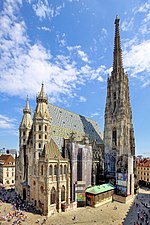Roman Catholic Archdiocese of Vienna

The Roman Catholic Archdiocese of Vienna (Latin: Archidioecesis Viennensis) is an archdiocese of the Catholic Church in Austria. It was erected as the Diocese of Vienna on 18 January 1469 out of the Diocese of Passau, and elevated to an archdiocese on 1 June 1722. The episcopal see resides in the cathedral of Stephansdom in Vienna. The current bishop is Christoph Schoenborn, appointed in 1995 and elevated to cardinal in 1998. The Archdiocese is the metropolitan diocese of three suffragan dioceses: Roman Catholic Diocese of Eisenstadt, of Linz, and of Sankt Pölten. These four dioceses together constitute the ecclesiastical province of Vienna, one of only two ecclesiastical provinces of Austria, the other under the Roman Catholic Archdiocese of Salzburg.
Excerpt from the Wikipedia article Roman Catholic Archdiocese of Vienna (License: CC BY-SA 3.0, Authors, Images).Roman Catholic Archdiocese of Vienna
Stephansplatz, Vienna Innere Stadt
Geographical coordinates (GPS) Address Phone number Website Nearby Places Show on map
Geographical coordinates (GPS)
| Latitude | Longitude |
|---|---|
| N 48.2085 ° | E 16.3731 ° |
Address
Stephansdom (Dom- und Metropolitankirche St. Stephan)
Stephansplatz 3
1010 Vienna, Innere Stadt
Austria
Open on Google Maps








